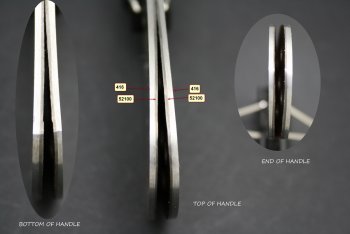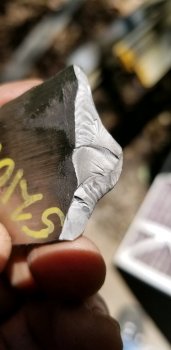Darrin Sanders
Moderator
Carbon = 1.00
Manganese = 0.35
Chromium = 1.50
Silicon = 0.25
This is just a reference, refer to the source/vendor for exact chemistry.
52100 is a bearing steel but it makes excellent knives. Proper heat treatment calls for accurate temp. control.
Heat treat;
1. Heat to 1475-1550 and soak for 5-15 min.. Lower temps. require longer soak times and higher temps. need less soak time.
2. Quench.
3. Temper twice for 2 hours each time. Temper between 325 & 450 depending on the application.
The above is just a starting point. You may need to adjust times and temps. to suit your equipment & needs.
I will add that Aldo's 52100 needs to be Normalized in order to fully harden. The following is what works for me and my equipment.
1. Heat to 1650, soak for 10 min., & air cool to black.
2. Heat to 1550, soak for 10 min., & air cool to black.
3. Heat to 1450, soak for 10 min., & air cool to black.
This refines the grain and the steel is now ready to harden.
Again, this is what works for me and my equipment. You may need to adjust times and temps. to suit your equipment.
Manganese = 0.35
Chromium = 1.50
Silicon = 0.25
This is just a reference, refer to the source/vendor for exact chemistry.
52100 is a bearing steel but it makes excellent knives. Proper heat treatment calls for accurate temp. control.
Heat treat;
1. Heat to 1475-1550 and soak for 5-15 min.. Lower temps. require longer soak times and higher temps. need less soak time.
2. Quench.
3. Temper twice for 2 hours each time. Temper between 325 & 450 depending on the application.
The above is just a starting point. You may need to adjust times and temps. to suit your equipment & needs.
I will add that Aldo's 52100 needs to be Normalized in order to fully harden. The following is what works for me and my equipment.
1. Heat to 1650, soak for 10 min., & air cool to black.
2. Heat to 1550, soak for 10 min., & air cool to black.
3. Heat to 1450, soak for 10 min., & air cool to black.
This refines the grain and the steel is now ready to harden.
Again, this is what works for me and my equipment. You may need to adjust times and temps. to suit your equipment.


